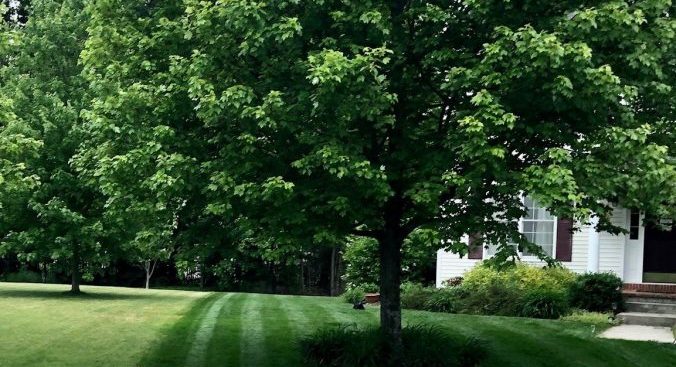Can you believe it’s July? The year is half over now! That includes our seven-month lawn care season, too. The outside temps are heating up, and by now, hopefully, you’ve completed our June lawn care schedule. If so, your lawns should be a deep dark green and growing like crazy. There are three main topics to cover for our July lawn care schedule.
Table of Contents
July Lawn Care Maintenance Schedule
- Grub Control & Treatment
- Grub Killers & Grub Control Products
- Fungus Control & Treatment
- Drought and irrigation
Grub Control
If you have active grubs in your lawn at this point, then the window to apply a preventative application of grub control has passed, so products like Merit – which contains imidacloprid as its active ingredient – may not be the best plan of attack. However, if there are no signs of grubs, then this will be a great product to use as long as it is thoroughly watered in.
If you haven’t applied a preventative treatment and notice grub damage, it’s time for curative measures. Dylox, the active ingredient trichlorfon, can cure active grubs if used correctly. Read the label, apply the recommended rates, and water in immediately. This will kill the grubs so you can stop the bleeding and think of a recovery/reseeding program (coming in the fall).
Bayer Advanced also sell smaller bags that, again, are more readily available at your local hardware and big box stores. Scott’s GrubEX is another option, but also better suited as an earlier preventative.
Remember that once grubs do damage, these products won’t fix the turf. Unfortunately, at this point, the grass is dead and you’ll need to repair and overseed – ideally in the early fall.
Fungus Control
Again, if you followed the June plan, then fungus should not be a major issue for you right now. We use the 1-2 punch of Azoxystrobin – and active ingredient in both Heritage G and Scott’s DiseaseEX – and Propicnizole are products I put down in throughout May and June, and have virtually no signs of fungus in my lawn.
As a preventative measure, these products can be applied every 21-28 days. However, if you’re struck with fungus – brown patch, melting out, dollar spot – then you’ll want to apply the curative rates every 10-14 days. As always, read the label for exact application rates.
The Lawn Forum has one of the best fungicide guides online and can give you a great head-start on what to use, and for the most cost-effective way.
Another great resource great resource here from NC STate Extension on diseases in turf, including the most common brown patch, dollar spot, red thread, and pythium blight.
Watering & Irrigation
- Drench: ~20 minutes – or 1/2″ of water, a couple of times per week to total one inch, to one and a half inches (1″ – 1.5″). Preferably in the early mornings
- Heal:. Short watertings in the late morning and mid-afternoon – about 5-6 minutes each time to cool the soil
- Spot: Hand-watering and spot-spraying hot-spots in the lawn
We go into more detail in our summertime lawn care tips.
Mowing
As we mentioned back in May and June – mowing your lawn is the single-most important lawn care task that you can control to build a thick, healthy turf. Raise your mower deck to increase the length of the cut turn. My TTTF is close to 4″ at this point. The taller the blades, the more shade it will provide the soil, and thus reduces heat stress.
Fertilization
I personally skip granular fertilizers in July and August. It’s just too hot outside. I don’t want to force any additional top-growth while the lawns begin to stress out due to the heat. And even worse if there’s a period of no rain and if your town has water restrictions or bans. Adding too much Nitrogen – even 1/2 lb. per 1,000 is forcing too much in my opinion.
However, if you must throw down on the 4th of July, use slow-release organic fertilizers such as Milorganite. However since Milorganite is still in a shortage until August/September, check out our post for some great Milorganite alternatives.
To calculate the amount of nitrogen per 1,000 ft2, be sure to be sure to use our free nitrogen calculator.
Micronutrients
Aa always, spoon feeding you lawn with humic acids and other micronutrients such as L-Amino acids into your lawn care plans. These, unlike your standard fertilizers, are generally safe to apply during the hot summer months. I’ve been using Kelp4Less Extreme Blend and Organic Humic Acid recently and am very pleased with the results. Each of these powders are under $20/lb. (with coupon codes) and can be easily mixed for backpack sprayer applications.
However with the increased temperatures, I’ll be limiting this to just humic acid and molasses powder – the latter to help eat up extra thatch.
July Spring Lawn Care Summary
- Prevent or cure grubs
- Cure or continue to prevent fungus
- Raise your mower deck
- Aim for 1″ – 1.5″ of total water each week
- Read our 5 summer lawn care tips
- Check out our Month-to-Month Lawn Care Calendar


